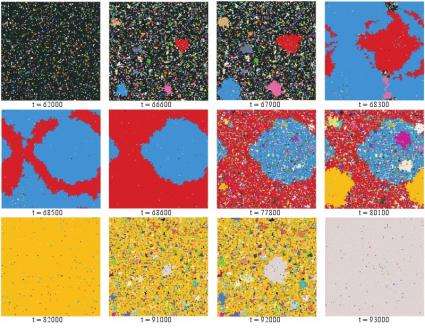February 22, 2011 feature
Model shows how scientific paradigms rise and fall

(PhysOrg.com) -- Scientific concepts such as climate change, nanotechnology, and chaos theory can sometimes spring up and capture the attention of both the scientific and public communities, only to be replaced by new ideas later on. Although many factors influence the emergence and decline of such scientific paradigms, a new model has captured how these ideas spread, providing a better understanding of paradigm shifts and the culture of innovation.
The researchers, Stefan Bornholdt from the University of Bremen in Bremen, Germany, and Mogens Høgh Jensen and Kim Sneppen from the Niels Bohr Institute in Copenhagen, Denmark, have published their study called “Emergence and Decline of Scientific Paradigms” in a recent issue of Physical Review Letters.
“Our model addresses the interplay between a new idea and the difficulty it has in displacing old ideas in a world where alignment of interests is dominating,” Bornholdt told PhysOrg.com.
Several models of opinion formation already exist, but the new model differs from earlier models in a few important ways. Unlike previous models, the new model allows for an infinite variety of ideas, although each idea has a small probability of being initiated. Also, each idea can appear only once, and an agent (or individual) cannot return to any of the ideas that they have previously held, reflecting scientists’ ongoing hunt for new ideas.
In the model, which is defined on a 2D square lattice, ideas spread in two possible ways. In the first way, an agent adopts a new idea held by its neighbors, with a probability proportional to how many agents already hold this particular idea. In the second way, an agent randomly gets a new idea that does not appear anywhere else in the system with a probability that depends on the “innovation rate.” The first way represents cooperative effects in social systems, while the second way represents innovation.
The model shows how a system with one dominating scientific paradigm transitions into a system with small clusters of ideas, some of which continue to grow until one dominates, and the process repeats with new ideas. The dynamics of the rise and fall of scientific paradigms depends on the system’s innovation rate. Systems with high innovation rates tend to contain a high degree of noise, along with many small domains of ideas that are constantly generated and replaced. In contrast, systems with low innovation rates tend to have low noise and a state that remains dominant for a long time until a single event replaces it.
In addition to providing a theoretical understanding of how scientific paradigms rise and fall, the model also provides insight that helps explain some observations in real life. For instance, the model shows how small systems have the potential to be more dynamic than large systems, which explains why large companies sometimes acquire small start-up firms as a source of innovation.
“Our model indicates that social cooperation makes it more difficult for new ideas to nucleate because of social pressure,” Bornholdt said. “Accordingly, our model finds a ‘winner take all’ dynamic, suggesting a fashion-like dynamic for the prevailing focus of contemporary science.
“Even though our model is extremely simplified and does not deal with right and wrong, it explores the effect of herd mentality in the propagation of ideas,” he added. “Our model suggests that herd mentality makes a larger system less innovative than several smaller ones. In short, for innovation it’s better to listen to yourself than to others.”
Overall, the model shows how new paradigms have a tendency to quickly rise to dominance, to decline slowly, and to quickly be replaced by other paradigms. When the innovation rate is high, the takeover process is chaotic, with many new ideas competing for dominance. Regardless of the idea itself, the model shows that the pattern of paradigm shifts remains fairly consistent over time.
The results could have implications for science philosophy and science policy, as the model suggests that scientific diversity may need special attention. In addition, the researchers are applying the model to the study of the spread of epidemics.
“We are currently studying the ideas of ‘new’ and ‘old’ in epidemics modeling,” Bornholdt said, “where the ‘never-return-policy’ of ideas in the above model is associated with immunity of infected hosts: A host that has been infected by a particular virus in the past will be immune to this virus in the future and, thus, will never acquire the same infection twice.”
More information: S. Bornholdt, M. H. Jensen, and K. Sneppen. “Emergence and Decline of Scientific Paradigms.” Physical Review Letters 106, 058701 (2011). DOI: 10.1103/PhysRevLett.106.058701
Copyright 2010 PhysOrg.com.
All rights reserved. This material may not be published, broadcast, rewritten or redistributed in whole or part without the express written permission of PhysOrg.com.


















